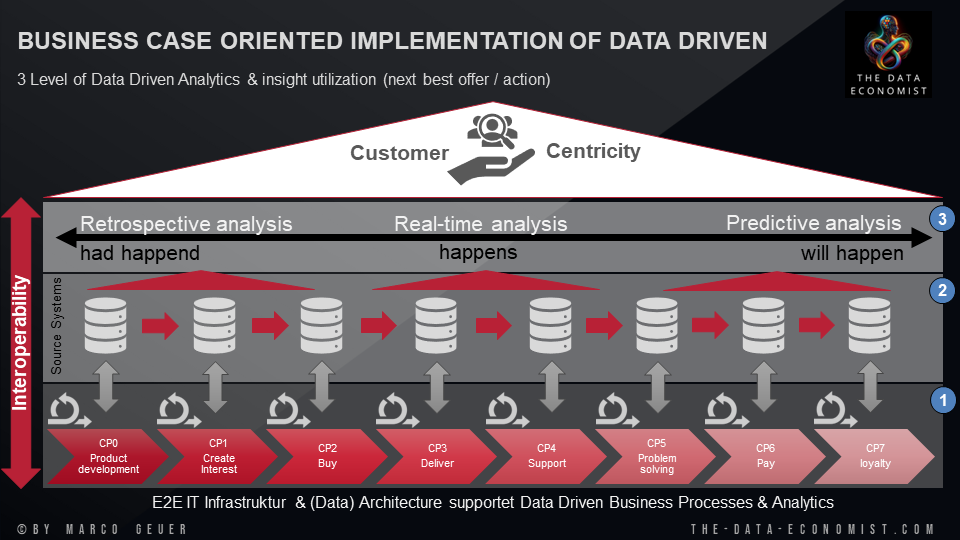Data & Prozess Interoperability
Data Driven Company - Data Intelligence Needs Data and Process Consistency
Only the triad of data consistency, process consistency, and consistent data analysis makes companies Data Driven and Customer Centric.
For a successful transformation into a data-driven company, it's crucial to uniformly view and understand processes and data and establish data consistency. This means data can flow seamlessly across various departments and systems, are in a consistent form, and continuously support operational processes and people.
The goal of data consistency is to ensure that all relevant data are available at the right places and can be analyzed in real time. When data are isolated or fragmented, information gaps and inconsistencies arise, leading to inefficient processes and inaccurate analyses. Establishing data consistency ensures uniform data access and exchange, leading to improved collaboration and faster decision-making.
Customer Focus
Focusing on the customer is a central aspect of a data-driven transformation. By uniformly viewing processes and data, companies gain a comprehensive understanding of their customers. Data on customer interactions, purchasing behavior, preferences, and feedback can be analyzed to gain informed insights. These insights enable companies to offer personalized offers, tailor-made service, and optimized customer experiences. By better understanding the needs and desires of customers, companies can improve their products and services and increase their competitiveness.
Benefits of Data Consistency
Data consistency, as a prerequisite for a successful transformation to a Data Driven Company, offers companies value on several levels:
- Holistic view: By establishing data consistency and uniformly viewing processes and data, companies can get a holistic picture of their activities and performance. This allows them to develop a comprehensive understanding of business operations and make informed decisions.
- Efficiency increase: Through seamless data flow in processes, companies can optimize and automate their operations. Data-driven processes enable faster and more precise execution of tasks, leading to improved efficiency and productivity, and the ability to reduce costs.
- Increased transparency: Viewing processes and data as a unit allows better transparency over the entire process flow. Data can be used to gain insights into the progress, bottlenecks, and effectiveness of processes as well as identify and optimize inefficient areas.
- Better decision making: Data-driven companies can access a wide range of data to make informed decisions. This allows leaders and employees to access real-time information and make decisions based on facts and trends, rather than relying on assumptions or gut feeling.
- Promotion of innovation: Viewing processes and data as a unit creates a basis for innovation. By analyzing data, companies can gain new insights, identify trends, and recognize new business opportunities. Data-driven companies are better positioned to develop new products, services, and business models to keep pace with changing market conditions.
- Improved data quality: A consistent data infrastructure allows companies to improve the quality of their data. This includes harmonizing data formats, eliminating redundancies and inconsistencies, and implementing mechanisms for data backup and validation. Better data quality enables informed decision making and better results.
- Comprehensive analysis capabilities: By establishing data consistency and uniformly viewing processes and data, companies can develop comprehensive analysis capabilities. This allows them to analyze data retrospectively to understand past trends and patterns, monitor current business states in real time to react promptly to undesirable changes, and conduct predictive analyses to anticipate future developments and opportunities.
Consideration of data in 3 time phases
The ability to consistently apply all three phases of analysis - retrospective, real-time, and predictive - is fundamental for data-driven companies and has several benefits:
- Retrospective analysis: By analyzing past data, companies can gain valuable insights and understand past performance, customer behavior, market trends, and other relevant factors. This helps in identifying patterns, mistakes, and opportunities for improvement.
- Real-time analysis: By monitoring and analyzing real-time data, companies can gain current insights into their business processes. This allows them to respond quickly to changes, identify problems, and take immediate action.
- Predictive analysis: By applying advanced analysis techniques, companies can make predictions about future events and developments. This enables them to identify opportunities, mitigate risks, and make informed strategic decisions.
By combining these three analysis phases, companies can gain a comprehensive understanding of their past, present, and potential future. This allows them to act proactively, be more competitive, and maximize their growth potential.

Data Strategy, Data Driven Company, Data Intelligence, Customer Centricity, Interoperability
- Geändert am .
- Aufrufe: 2886
